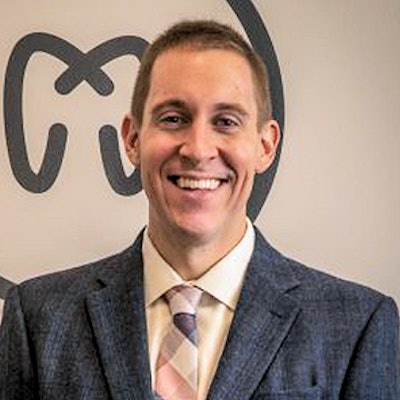
Teamwork is an essential component of running a successful practice. And while many practice managers love to talk about their ability to cultivate a great team, patients will know the truth in under 30 seconds at your office.
Taking it a step further, cultivating a great team is not just beneficial for your quality of life at work -- a great team also has a huge influence on your business' bottom line. So sure, we'll throw parties, joke around, and help in our community because we'll have a more enjoyable life from 9 to 5 on Monday through Thursday. However, we'll also do it to make our practice much more profitable in 2020.
 Mike Monfredi.
Mike Monfredi.What does this mean? It is incredibly difficult and expensive to seek out prospective new patients, market your services to them, get them in your office, and keep them coming back. However, perhaps the most difficult step in the life cycle of new patients is selling them the treatment they need. And, the fact is, people will buy more services from someone (or a business) they like, respect, and enjoy being around. The great news for us is that we can check all three of those boxes by accomplishing one straightforward task: cultivating a phenomenal team.
Here are five ways to build teamwork into your practice culture.
1. Turn individual team member's goals into goals for your practice
Show your team that their semiannual performance reviews are actually worth their time by turning the tables. Rather than dictating your opinion of their performance the entire meeting, schedule at least 25% of the time to cultivate and discuss goals for each person.
At our office, we ask our employees to come to their first semiannual review meeting with three to four goals for the year ahead. These goals may include the following:
- One or two professional goals (continuing education, certifications, additional dental skills, etc.)
- One personal goal for the year (reading, fitness, community involvement, etc.)
- One goal for our team as a business
The team goals are my absolute favorite for a few reasons. First, we've had so many tremendous experiences as a group due to these goals, such as volunteering at a local food bank and educating elementary school kids about dental hygiene. Also, the process of setting measurable and far-reaching goals as individuals and as a team forces us to listen to our people, find out who they are as individuals, and grow together.
The keys after the initial meeting are threefold:
- Create a plan with a target end date for each goal.
- Nurture your team's ability to achieve their goals by taking part in the planning and execution.
- Reflect on past goals (either at the midyear review or one year after the initial meeting).
People will work harder for a business they feel they have some actual ownership in, and a legitimate way to provide them with a sense of ownership in the practice is to turn a goal that's important to them into a goal that's important to your practice as a whole.
2. Challenge your team
Sharing a common painful experience builds better cohesion than positive experiences. A 2014 study in Psychological Science by the Association for Psychological Science (APS) reports that pain "acts as a social glue that fosters cohesion and solidarity within groups." The researchers went on to state that "shared pain not only increases a sense of solidarity, it can also boost actual group cooperation."
Notice that APS doesn't qualify setting production goals as legitimate "painful experiences" for your team. To achieve real "pain," you may need to break out of the world of dentistry to make a significant mark on someone's state of mind. We've used team boot camps, 5K races, and competitions in other venues to bring us closer together. You could also try ropes courses, hiking, canoeing, mental challenges (like an escape room) as potential stand-ins for nondental adversity. Each of which has the potential to create strong and lasting bonds.
3. Give back to your community together
While sharing painful experiences may do wonders to form lasting bonds, joyful ones can help too. In fact, volunteering your time toward some community service has been shown to decrease the risk of depression, reduce stress, and provide a sense of purpose, according to the Mayo Clinic.
Our team recently had the opportunity to volunteer some time at a local soup kitchen (as part of a teammate's goal, see the first point above). Each of our staff members left that day with a renewed sense of accomplishment and perspective on life. We may not have significantly changed the world with those few hours we spent working in our community, but we were able to help in some small way. And the most important part? We accomplished that mission together.
 Image courtesy of Mike Monfredi.
Image courtesy of Mike Monfredi.Oh, and if that's not enough, volunteering (as an individual or as a group) may help you live longer too. That's also from the Mayo Clinic.
4. Break bread
"Room 5 needs to be flipped. Is the crown ready in room 2? The patient could use a little help with their flossing technique in room 4."
Discussing jargon and patient needs 100% of the time you're with your team doesn't do much toward building lasting bonds and a sense of cohesion. It's important to get out of the office and break bread together. We've tried barbeques at the house, nights out for dinner and drinks, or happy hours as options to shift the conversation toward our actual lives rather than the clinical needs of our patients.
The stories we share and the information we learn about our people in these different settings helps me, as a practice manager, in three ways:
- I can take what I learn about them to deliver business or clinical information in a manner in which they'll best relate.
- I learn to see what factors in their personal lives may be affecting their performance at work (whether negatively or positively).
- We grow in unity as a group as we learn more about each other. The sense of team grows.
As a side note, if you're thinking to yourself right now, "I really don't want to spend more time with these people than I have to," then I will leave you with this. We went into business for ourselves to have total control of the experience. You control who works at your office and, more importantly, the culture you cultivate. Make sure you're working with people you'd care to learn more about because, if you're not, there's only one person to blame for that.
5. Give them a business to be proud to work for
Finally, we can preach about "our awesome team" and "our great culture" all we want. However, if you don't back up your words with actions, the business and the team will never reach its full potential.
When we bring on a new hire at our business, I'm constantly checking that person's social media profiles. Not for anything malicious, but rather to see how long it takes them to change their employment status to say "Monfredi Family Dental." I want them to be so excited to come to work with us that they can't wait to tell their friends and family. Our personal record is 10 minutes after receiving an offer letter.
How do we instill that strong sense of attraction as an employer? Well, we still have a long way to go, but each day we work incredibly hard to build and protect our brand. A brand that cares for people, both within our team and within our community, one that gives back, and one that will help its people grow and prosper. But most importantly, we work every day to build bonds you can't find anywhere else. We build a team.
Mike Monfredi is the practice manager at Monfredi Family Dental. He also writes about entrepreneurship, finance, and fitness at MikedUp Blog.
The comments and observations expressed herein do not necessarily reflect the opinions of DrBicuspid.com, nor should they be construed as an endorsement or admonishment of any particular idea, vendor, or organization.



















